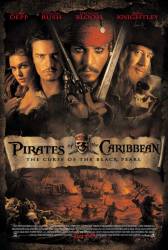Factual error: During Jack's sliding down the rope scene, it is very noticeable that each one of the English soldiers fire their weapons more than once, which is impossible for that time, knowing that repetition weapons weren't invented until the mid 1800s. (00:20:00)
Factual error: Captain Norrington is "promoted" to Commodore. However, commodore was not a rank in the British navy (it is now, not then), but a posting. A post captain could be appointed commodore (meaning he commanded more than one vessel) for a specific task, but when that task was completed, he became a post captain again. A promotion would have made Norrington an admiral. (00:11:30)
Factual error: When Will delivers the new sword to Governor Swann, look behind Governor Swann. There is an oval painting hanging on the wall. It is a Thomas Kinkade portrait, which would never grace the walls of the mansion. Thomas Kinkade is a modern artist. (00:07:20)
Factual error: After Will And Jack commandeer the Interceptor, the ship is viewed from above, sailing on a beam reach (a point of sail in which the boat is at 90 degrees to the wind). When Jack knocks Will off the ship with the boom, he jibes the boat, causing the sail to shift positions suddenly. In order to do this from the previous position, he would have had to turn the ship almost completely around. This would have taken well over a minute. Jack did this in less that three seconds. The sail is also filled to the wrong side while it sweeps Will off the deck.
Factual error: Viracocha is sculpted on the "Aztec" chest of golden coins, but is not an Aztec god.
Factual error: Near the start, Jack steps from the yardarm of the sinking craft onto the dock. However, as it is a sailing craft, there is no way that it could have continued its forward movement once the sail was under water, even discounting the drag effect that the sail would have had in the water. Once the sail is submerged, it would act as a type of anchor. (00:10:00)

Factual error: Sir Charles Wheatstone, an English physicist (b.1802 - d.1875), invented the 'concertina' around the mid 1800's. The 'concertina' is a small musical instrument like an accordion, with bellows and keys. During the Moonlight Serenade scene, when Elizabeth walks out onto the deck, she sees the skeletal pirates for the first time, and Jacoby is seen playing the 'concertina', but it was not invented yet. (00:58:45)
Factual error: When Norrington is "promoted" to Commodore (already addressed as an error in and of itself), the promotion ceremony held for him in Port Royal would have been meaningless. A commander-in-chief of a foreign station in the British Navy could indeed promote acting officers beneath him, but these commissions would be unofficial until confirmed by the Lords of the Admiralty in London. And as it appears that Norrington is the commander-in-chief at his station, there would be no one to promote him at all - a governor, such as Swann, did not have the authority to do so. The only actual, official ceremonies of promotion in the Royal Navy was for a captain to be given his commission, and to be "read in" aboard his ship, the formal act of taking command. There would be little cause for celebration until a commission was confirmed by the "Sea Lords," in any case.
Factual error: Elizabeth would not have slept undercovers, nor would she have needed a bed warmer in Jamaica in an un-air conditioned room.
Factual error: During the attack on Port Royal, at the beginning of the movie, the guns on the Black Pearl are firing at a far greater elevation than they would have been able to at the time.
Factual error: The British warships in the film - and in the whole series, for that matter - are painted in a livery far too modern for the period in which the film is evidently set. The "Golden Age of Piracy," during which the movie takes place, occurred in the early 1700s, but the Royal Navy did not begin using the yellow-and-black "Nelson Chequer" on its vessels until the Battle of Trafalgar in 1805. Even if the film were actually set in the later period, there would still be an inaccuracy in that the Marines' headwear would be incorrect - they transitioned from the tricorne to a round hat in 1802.
Factual error: The scriptwriters revealed that they placed the story in a thirty-year environment set loosely between 1720 and 1750. Port Royal was destroyed by an earthquake on 7 June 1692, which had an accompanying tsunami. An initial attempt at rebuilding was again destroyed in 1703 by fire. Subsequent rebuilding was hampered by several hurricanes in the first half of the 18th century. I don't remember if the movie was set in a big, undestroyed Port Royal. However there was also set a huge fortress in Port Royal, which is definitely a factual error.
Suggested correction: This is also not the real world. It's set in an alternate reality which doesn't have to exactly match our reality.
Although the film series falls into the fantasy genre, it is set in a real period and place in history. Fictional events taking place in a historical setting is not the same as an "alternate reality." The anachronistic use of a real city as an important locale in the story is not artistic license, it is a historical error.





